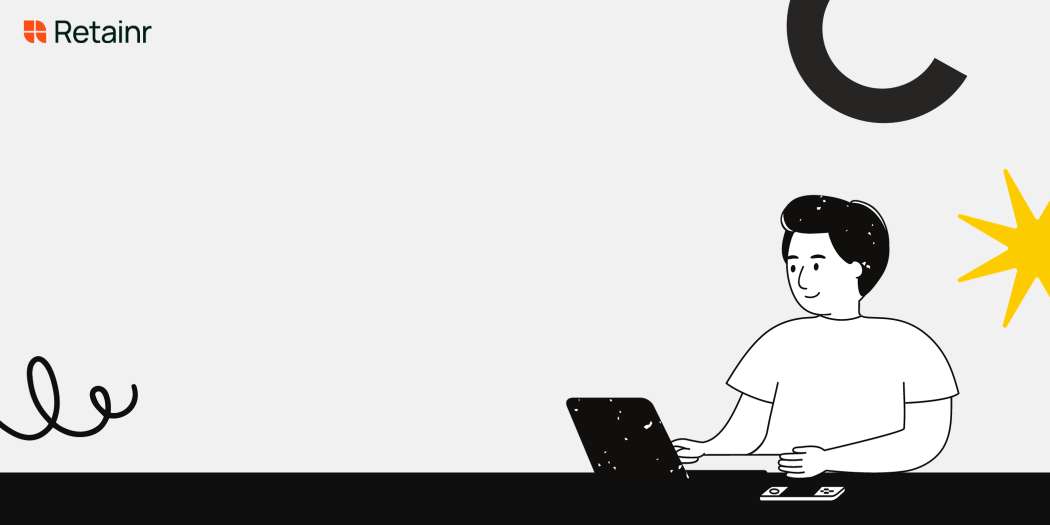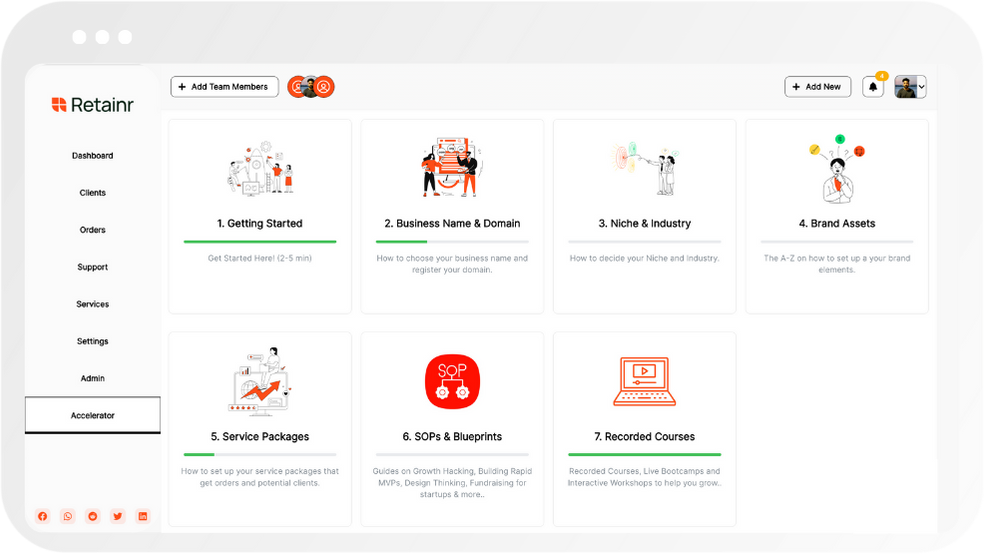
How can remote work support enhance productivity and efficiency
Build with Retainr
Sell your products and services, manage clients, orders, payments, automate your client onboarding and management with your own branded web application.
Get Started1. How can remote work support improve productivity and efficiency?
Benefits of Remote Work Support
Remote work support enhances productivity and efficiency in several ways. Firstly, it enables flexibility. Employees can work at their prime times, be it early morning or late at night, which ensures optimal performance. Hence, there is greater productivity. Secondly, it reduces downtime as employees don't need to overcome obstacles such as commuting or office distractions, allowing them to stay focused on their tasks. Additionally, studies show that happy employees are more productive, and remote work encourages a satisfactory work-life balance.
Tools for Remote Work Support
Various tools are available that make remote work smoother and more efficient. Collaboration tools like Slack or Microsoft Teams bring teams together, making communication and collaboration easier. Project management tools like Jira and Trello help in managing tasks and tracking progress. These tools significantly enhance productivity by keeping everyone connected and informed.
Remote Work and Employee Efficiency
| Factors | Impact on Efficiency | |
|---|---|---|
| Flexible Schedules | Allows employees to work during their most productive hours. | |
| Reduced Commute | Saves time and energy, which can be directed towards work. | |
| Improved Work-Life Balance | Leads to happier, healthier employees who are more dedicated and productive. |
| Tool Category | Key Advantages |
|---|---|
| Communication tools | Facilitates real-time communication, fosters relationships among team members, and promotes a collaborative work environment. |
| Project and Task Management tools | Enhances organization, assigns responsibility, tracks work progress, and improves visibility and transparency in work processes. |
| Collaborative tools | Allows multiple users to simultaneously work on a single project, helps keep projects on schedule, and ensures consistency in work. |
| Time management tools | Promotes productivity by tracking work hours, breaks, project time, providing insights on work habits, and encouraging efficient time use. |
Seamless Integration for Increased Productivity
Using these tools in isolation may not give the desired productivity boost. However, when integrated correctly, they can provide a seamless workflow enhancing productivity and efficiency in remote work. For instance, integrating communication tools with project management tools can allow for swift clarification of tasks without having to switch between platforms. Similarly, integrating time management tools with project management software can provide a more comprehensive picture of work progress. Therefore, the key to enhancing productivity in remote work lies not just in the tools but how well they are coordinated to support the workflow.
3. How can managers measure productivity and efficiency in a remote work situation?
Methods for Measuring Productivity and Efficiency in Remote Work
When it comes to remote work, evaluating productivity and efficiency requires a different approach as compared to traditional office settings. While it may seem challenging, a few practical methods can help managers measure their team's performance effectively.
- Setting clear expectations: Managers can set weekly or monthly goals and deadlines for projects. These expectations will act as a measurement tool for assessing the productivity and efficiency of each member.
- Utilizing productivity tracking software: This software can record the time spent on each task, allowing leaders to track and measure work done throughout the day.
- Performance reviews: Regular performance reviews can give a broader perspective on an employee's work. It also provides an opportunity for employees to receive feedback and improve.
- Encouraging communication: By encouraging open communication, managers will understand the challenges their employees are facing and figure out ways to improve their productivity and efficiency.
The Role of Technology in Measuring Productivity
Technology plays a crucial role in measuring productivity in a remote work setting. Innovative project management and communication tools have advanced functionalities that enable better tracking and measurement of team productivity. Below is a table showcasing some of the most common tools used in remote work scenarios and their functionalities.
| Tool | Functionality |
|---|---|
| Asana | Project management and collaboration tool that helps teams organize, track, and manage their work. |
| Slack | Communication platform that facilitates collaboration and real-time communication amongst team members. |
| Zoom | Conferencing tool that offers video conferencing, online meetings, and chat functionalities to facilitate remote communications. |
| Toggl | A time tracking tool that helps to accurately measure how much time has been spent on each task. |
Addressing the Challenges of Measuring Productivity
Recognizing the challenges faced while measuring productivity and tackling them head-on is essential for the efficient management of remote teams. Some common hurdles might include:
- Difficulty in monitoring work hours accurately
- Lack of face-to-face interaction
- Problems in communication due to lack of proper equipment
By strategically addressing these challenges, managers can better assess productivity and foster a supportive and efficient remote work environment.
4. How do communication tools enhance productivity and efficiency in remote work?
Role of Communication tools in Enhancing Productivity and Efficiency
Sufficient and efficient communication is a core component of remote work, and it's through this, that productivity and efficiency are enhanced. For open and instant communication across diverse geographical areas, organizations rely on advanced communication tools. These tools have numerous features which support decision-making processes, instantaneous communication, team collaboration, and organization.
- Emails are often used for official and formal communication. They help create a chronological order of conversations and can be easily referenced. Meanwhile, instant messaging apps like Slack and Microsoft Teams provide quicker and spontaneous communication.
- Video conferencing tools such as Zoom and Skype help in conducting virtual meetings, brainstorming sessions, and one-on-one engagements. These real-time, face-to-face interactions foster stronger relationships and collaboration amongst team members.
- Project management tools such as Asana and Trello enhance productivity by allowing team members to view, track, and manage tasks efficiently.
Understanding the Impact of Communication tools on Productivity and Efficiency
The table below summarizes how different communication tools improve productivity and efficiency in remote work:
| Communication Tool | Impact on Productivity and Efficiency |
|---|---|
| Emails | Promotes organized and comprehensive communication, enables tracking of tasks and conversations. |
| Video Conferencing Tools | Supports real-time collaboration, immediate feedback, and enhances team cohesion. |
| Project Management Tools | Streamlines task management, ensures timely completion of tasks, improves task visibility and accountability. |
| Instant Messaging Apps | Facilitates quick decision making, immediate problem-solving, and encourages casual interactions. |
Focusing on the Benefits of Communication Tools for Remote Work
Communication tools offer a myriad of benefits, including improved team collaboration, a streamlined work process, efficient task management, and reduced response times. Firstly, these tools keep remote employees connected, making it easier for them to work together on the same project. Secondly, they automate work processes, reducing the time spent on task management. Lastly, they ensure messages are passed on instantly, reducing waiting time and speeding up project completion. By driving more effective communication and collaboration, these tools ultimately enhance productivity and efficiency in remote work.
5. What strategies can organizations implement to boost efficiency in remote work settings?
Strategies to Improve Efficiency
There are several strategies that organizations can implement to boost efficiency and productivity among their remote workforce. One of these strategies is to invest in the right resources and tools. This would include high-quality video conferencing software, project management tools, secure VPNs, and other communication platforms.
- Video conferencing software: Facilitates collaboration, teamwork, and idea sharing among remote team members.
- Project management tools: Ensure everyone is on the same page about project objectives and timelines. Provides a clear view of workloads and deadlines.
- Secure VPNs: Reduces the risks associated with cybersecurity and maintains the confidentiality of data.
- Communication platforms: Aids in maintaining regular communication and fosters a sense of community within remote teams.
Organizing Regular Team Meetings and Check-ins
Another strategy revolves around maintaining the human touch by organizing regular team meetings and check-ins. This can help prevent workers from feeling isolated and detached from their colleagues and managers. It can also ensure that everyone is aware of their roles and responsibilities and can bring to light any issues or concerns that might affect productivity.
| Meeting Type | Purpose |
|---|---|
| Daily check-ins | To share updates and progress reports |
| Weekly team meetings | To discuss team objectives for the upcoming week |
| Monthly reviews | To assess performance and address any concerns or issues |
Providing Regular Training and Learning Opportunities
The final strategy is to focus on professional development. Organizations should provide regular training and learning opportunities to their remote workers. By improving their skills and knowledge, these workers can continue to contribute effectively to the organization, thereby boosting both efficiency and productivity.
- Webinars: Helps remote teams stay updated with industry trends.
- Online courses: Boosts their knowledge and skills, thereby enhancing their job performance.
- Virtual conferences: Enables them to learn from experts and thought leaders within their industry.
- E-books and guides: Provides in-depth knowledge on various topics related to their work.
6. What is the role of technology in enhancing productivity and efficiency in remote work?
The Vital Role of Technology in Remote Work
Technology has fundamentally transformed the concept of work, particularly in the context of remote work. It provides the bridge between employees and their tasks, colleagues, and superiors. As such, technology is the backbone of remote work, fostering productivity and efficiency.
Crucial Technological Tools for Remote Work Productivity
The utilization of appropriate and efficient technological tools is critical for enhancing productivity in a remote work set-up. These tools include:
- Project Management Tools: Applications such as Trello, Asana, and Monday.com help employees to organize tasks, track progress, and effectively collaborate with team members. These tools streamline work processes to increase productivity.
- Communication Tools: Platforms like Slack, Zoom, and Google Hangout ensure seamless communication among teams. They provide a virtual space for instant messaging, video conferencing, and document sharing.
- Time-trackers: Tools like Toggl and TimeDoctor help monitor time spent on tasks, providing insight into personal productivity patterns. They also provide accountability for time allocated to each task.
Table Showing Efficiency and Productivity Benefits of Various Technological Tools for Remote Work
| Technological Tool | Potential Productivity Benefits | Potential Efficiency Benefits |
| Project Management Tools | Enhanced task organization and progress tracking | Simplified work processes and improved collaboration |
| Communication Tools | Streamlined communication processes | Faster decision-making processes and improved collaborations |
| Time-trackers | Better time management and accountability | Increased understanding of individual productivity patterns leading to optimized work schedules |
7. How can a flexible schedule improve efficiency and productivity while working remotely?
Benefits of Flexible Schedules in Remote Work
One primary aspect of remote work is the flexibility to set your work schedule, boosting overall productivity and efficiency. A flexible schedule reduces stress and increases job satisfaction, fostering a healthier work-life balance, leading to enhanced productivity.
- Customized Productivity: Everyone has different peak productivity hours. A 9-5 schedule may not fit every employee, some may function better early in the morning, others late at night. Flexibility in choosing work hours allows employees to align their work with their peak performance time.
- Reduced Commute: Flexible schedules often mean no commute time. This can result in substantial time savings, which can be used productively for work or relaxation, both of which indirectly contribute to work efficacy.
- Better Work-Life Balance: A flexible schedule means employees can balance personal commitments without compromising their work, reducing work-related stress and subsequently increasing work performance.
Increase in Efficiency with Flexible Schedules
When it comes to efficiency, flexible schedules have demonstrated great outcomes in remote work. More control over the work schedule means employees can plan their work strategically to avoid interruptions and manage high-priority tasks effectively.
| Scenario | Efficiency |
|---|---|
| Working at Peak Energy Hours | High |
| Planning Work Around Personal Tasks | Moderate to High |
| Avoiding Distractions During Work Hours | Moderate to High |
Maintaining Productivity and Efficiency with Flexible Schedules
While flexible schedules offer numerous benefits, maintaining productivity and efficiency requires discipline, good time-management, and focus. Here are a few strategies to maximize benefits from a flexible schedule:
- Consistency: Despite flexible work hours, maintaining a consistent schedule helps set boundaries and maintains productivity.
- Task Batching: Organizing similar tasks together can maximize focus and optimize productivity.
- Communication: Effective communication about availability with team members prevents confusion and helps maintain collaboration.
8. How can breaks and self-care improve remote work productivity and efficiency?
The Importance of Breaks in Remote Work
Remote work can often blur the line between personal time and work time, leading to potential burnout and reduced productivity. Regular breaks can help prevent this problem by providing the much-needed rest and rejuvenation. Some of the major benefits of breaks include:
- Restoring mental energy: Just like physical effort, mental work also drains our energy. Breaks can help restore this energy.
- Improving creativity: By breaking the cycle of work, breaks can often lead to greater creativity as the mind gets to relax and potentially form new connections.
- Experiencing less physical strain: Especially for office workers who spend most of their day sitting, regular breaks can help reduce the risk of physical health issues such as obesity and cardiovascular disease.
The Role of Self-Care in Enhancing Remote Work Productivity
Self-care is another important factor that can significantly improve remote work productivity and efficiency. It includes activities that you do voluntarily to maintain your physical, mental, and emotional health. Some of the self-care practices that can boost your productivity are:
- Maintaining a regular exercise schedule: Regular exercise can help clear your mind, reduce stress, and improve your mood, making you more productive.
- Ensuring adequate sleep: Adequate sleep is essential for maintaining concentration and cognitive function.
- Eating a balanced diet: The food you eat can significantly affect your mood and energy levels, thereby affecting your productivity.
Improving Productivity and Efficiency with Breaks and Self-Care Practices
| Self-Care/Break Practices | Productivity and Efficiency Gains |
|---|---|
| Regular Breaks | Restores mental energy, enhances creativity, and reduces physical strain. |
| Regular Exercise Schedule | Improves mental clarity, reduces stress, and enhances mood. |
| Adequate Sleep | Improves concentration and cognitive function for high efficiency. |
| Balanced Diet | Nutritionally balanced food choices lead to sustained energy levels and enhanced mood, improving productivity. |
9. How can remote work support help in reducing workplace stress and increase productivity?
Reducing Workplace Stress Via Remote Work Support
Remote work can significantly contribute to reducing workplace stress, which in turn increases productivity. Let's break this down into bullet points:
- Work-Life Balance: Remote work allows flexibility in setting up a working schedule that aligns with personal life activities. This helps reduce the stress of managing both work and personal life simultaneously.
- Elimination of Commute: The daily commute involves dealing with uncontrollable factors such as traffic and unreliable public transportation. Remote work eliminates this, reducing stress and freeing up time.
- Personal Environment: Remote work allows employees to create a personalized, comfortable work environment, leading to less stress and more productivity.
Increasing Productivity Through Remote Work Support
On the other hand, remote work support can also increase productivity. Below are significant factors:
| Factor | Description |
|---|---|
| Reduced Distractions | Many remote workers report fewer distractions than in an office setting, allowing them to focus and be more productive. |
| More Autonomy | Remote work often fosters a sense of autonomy and responsibility. With independence can come increased motivation and productivity. |
| Flexible Hours | Workers have the freedom to work during their most productive hours, leading to an overall increase in productivity. |
Link Between Reduced Stress and Increased Productivity
Ultimately, the link between reduced stress and increased productivity through remote work lies in the employee's improved wellbeing and better working conditions. With stressors from the office environment eliminated and the benefits of flexible hours, fewer distractions, and increased autonomy, remote workers tend to be happier, healthier, and more productive. A well-established remote work support system encourages these factors, leading to a more efficient and productive workforce.
10. How can setting clear expectations enhance productivity and efficiency in remote work situations?
Setting Clear Expectations for Remote Work
Defining clear expectations plays a significant role in the success of remote work scenarios. Whether it's about work schedules, tasks, or communication protocols, well-defined expectations help reduce confusion and ambiguity. This consequently leads to improved productivity and efficiency amongst workers. Here are a few ways in which clear expectations could improve work output:
- Improved Focus: Workers know what they need to concentrate on, leading to less wasted time and distractions.
- Increased Accountability: Clearly defined roles and responsibilities enhance ownership and initative.
- Better Time Management: A clear list of tasks helps workers plan their activity and manage their time effectively.
Case Study: The Impact of Clear Expectations on Productivity
The following table provides an illustration of a simple case study where clear expectations were set in a remote working setup and the resulting impact on productivity and efficiency:
| Company | Strategy | Result |
|---|---|---|
| ABC Corp. | Created detailed work schedules and task breakdown for all employees. | 20% increase in productivity |
| XYZ Ltd. | Established clear communication protocols and accountability guidelines. | Reduced time wasted in unproductive meetings, and increased overall efficiency by 15% |
Implementing Clear Expectations
Implementing clear expectations in a remote work setup initially requires some planning and communication but it ultimately results in a more streamlined work process. Here are a few steps to achieve this:
- Task Breakdown: Breakdown projects into manageable tasks and clearly assign them.
- Define Timelines: Provide clear deadlines to ensure tasks are completed in a timely manner.
- Establish Communication Norms: Define what, when and how information should be communicated.
- Regular Feedback: Regularly discuss expectations and provide constructive feedback. This helps in continually improving the remote work setup.
Conclusion
```htmlEnhancing Productivity and Efficiency through Remote Work Support
In the current digital age, remote work has become a vital part of many businesses. With the right support, it can significantly enhance productivity and efficiency. It not only provides flexibility, but also eliminates commuting time, leading to increased productivity.
The Role of Software in Remote Work
Quality software is a key aspect of remote work support. Today, there are various software solutions that help manage remote teams effectively, streamline work processes, and ensure seamless communication.
Introducing Retainr
One such software is Retainr.io, a whitelabel software that gives businesses the ability to sell, manage clients, orders, and payments through their own branded app.
How Retainr Boosts Productivity and Efficiency
With Retainr.io, businesses can manage their operations remotely with ease. Its robust suite of tools allows for streamlined task management and effective client engagement, thereby enhancing productivity and efficiency. By effectively utilising Retainr as a part of remote work support, businesses can propel their growth while maintaining consistency and quality.
Conclusion
In conclusion, the right support in the form of software like Retainr.io is crucial in making remote work more productive and efficient. Being able to manage your business effectively no matter where you or your team are located is the key to success in today’s digital-first environment.
```Boost Your Agency Growth
with Retainr Accelerator
Uncover secrets, strategies, and exclusive blueprints to take your agency's growth to the next level — from marketing insights to effective presentations and leveraging technology.

SOPs, Cheatsheets & Blueprints
Leverage 50+ SOPs (valued over $10K) offering practical guides, scripts, tools, hacks, templates, and cheat sheets to fast-track your startup's growth.
Connect with fellow entrepreneurs, share experiences, and get expert insights within our exclusive Facebook community.
.jpg)

Join a thriving community of growth hackers. Network, collaborate, and learn from like-minded entrepreneurs on a lifelong journey to success.

Gain expertise with recorded Courses, Live Bootcamps and interactive Workshops on topics like growth hacking, copywriting, no-code funnel building, performance marketing and more, taught by seasoned coaches & industry experts.

.jpg)

.jpeg)


